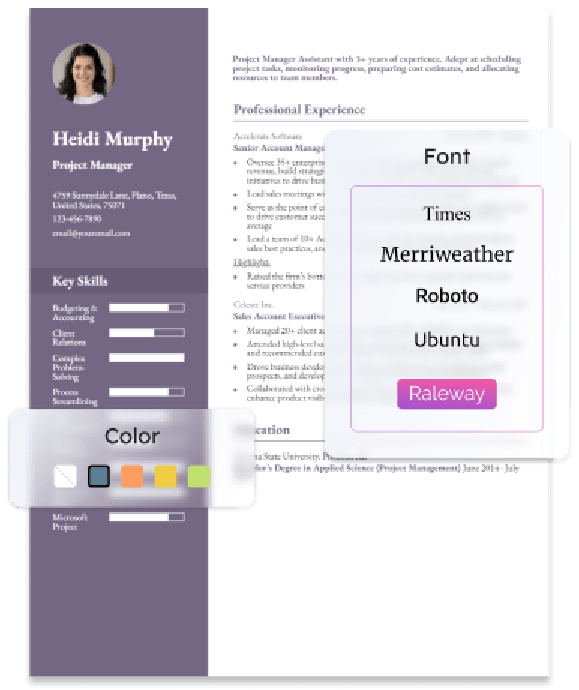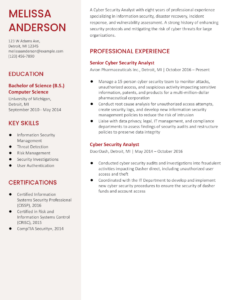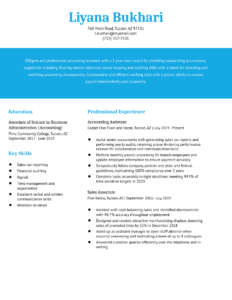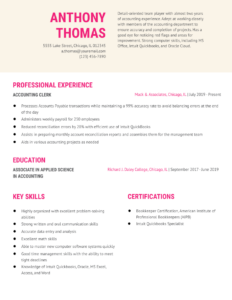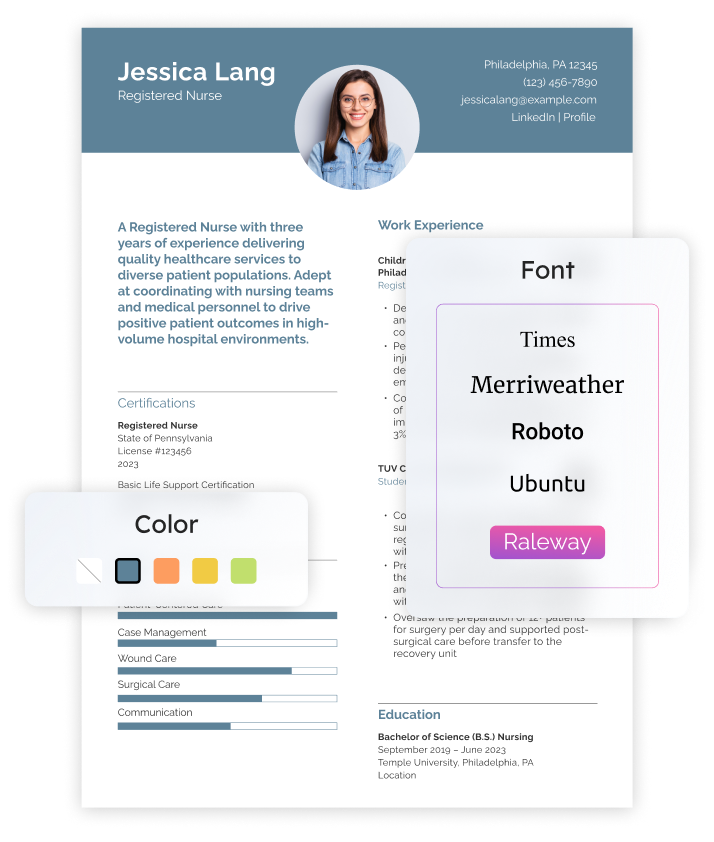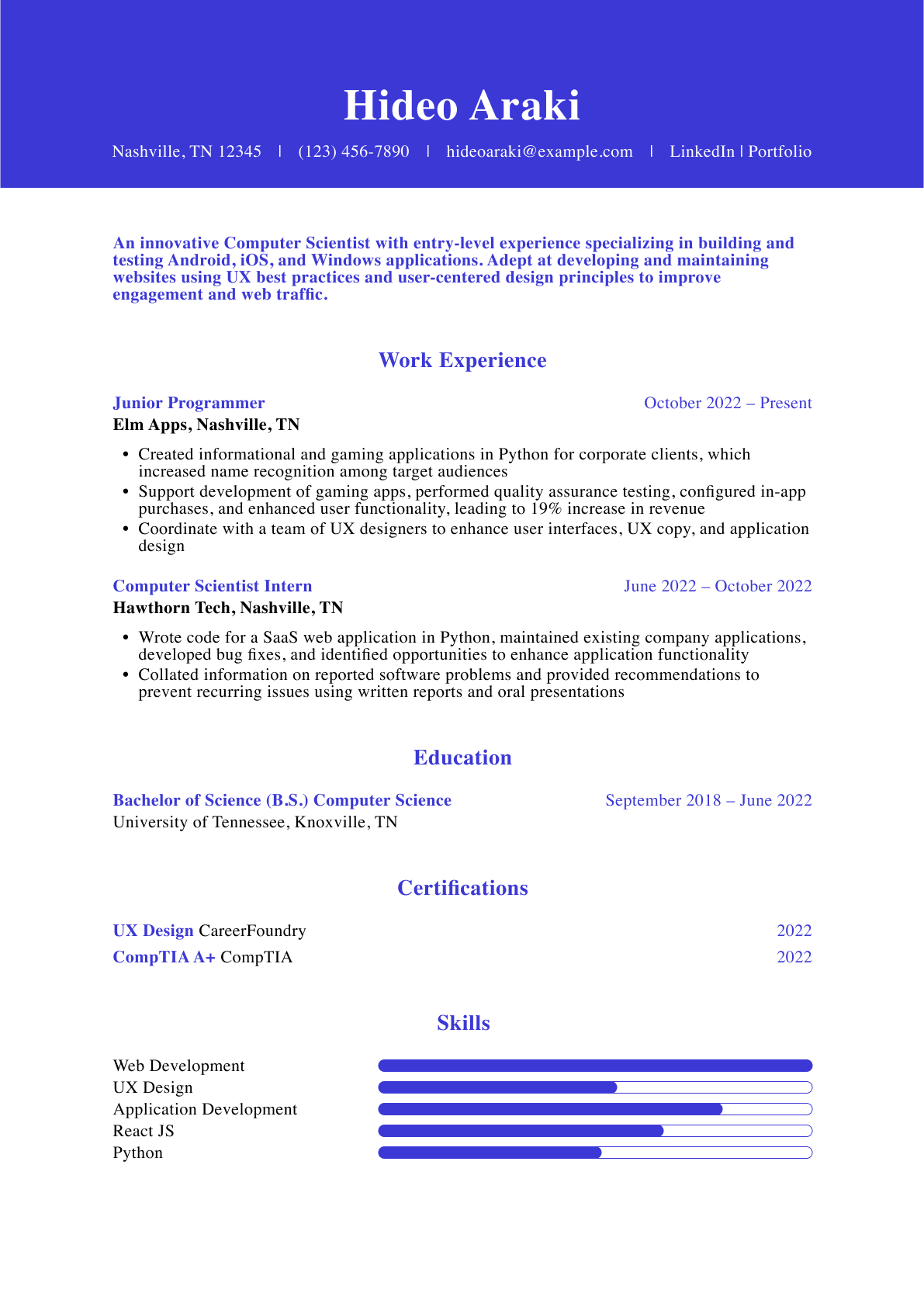How To Write a User Experience Designer Resume
Writing a user experience (UX) designer resume is similar to developing a landing page or app interface. You start with a list of requirements, use your resources to complete the project to specs, and take some time to review and polish the finished product.
This guide provides step-by-step guidance for applying those skills to resume creation. It walks you through creating the various components of a resume, including a summary, professional experience section, and skills list. It also offers expert tips to help you translate the nuances of your UX design career into an accomplishment-driven document.
- Entry-level
- Mid-career
- Senior-level
1. Write a brief summary of your user experience (UX) designer qualifications
Start your resume with a hook that gives the hiring manager reasons to look more closely at your document. You might include your tenure as a UX design professional, pepper in some of your more unique and impressive skills, or provide a metric or two that tells the employer how you can help.
Don’t write a lengthy paragraph — or more than one. Keep this section to a few sentences, combining information in concise statements. For example, you might write about your five years of experience with wireframing and web development or your ability to leverage user stories to influence positive experience outcomes without impacting compliance in heavily regulated industries.
Senior-Level Profile Example
A Senior UX Designer with 10+ years of experience, specializing in UX research, design systems, UI prototyping, and user-centered design. A proven track record of managing UX teams to develop design solutions for an unparalleled user experience. Adept at leading all aspects of the creative process and collaborating with C-level stakeholders.
Entry-Level Profile Example
A UX Designer with three years of experience specializing in usability design, user-centered design, prototyping, and design thinking. A proven track record of coordinating with cross-functional teams to create holistic user experiences.
2. Showcase your user experience (UX) designer experience
Your professional experience section serves as the foundation of your resume. Think about your achievements and what might resonate most with a specific employer. Highlight those details in this section, building a narrative that demonstrates your value as a UX designer.
Emphasize big-picture business results and how your UX design work helped meet those goals. Tell your unique story as an industry professional by providing insights into specific projects and achievements. For example, you might note you “introduced visual storytelling into design processes, creating user-friendly marketing and web experiences that increased engagement by 40%.”
Senior-Level Professional Experience Example
Senior UX Designer, Employee Software Inc., San Francisco, CA
May 2015 – Present
- Manage a team of 25+ UX designers to develop a new user interface for an HR software application generating $30M in revenue, which includes coordinating all phases of design, prototyping, and quality assurance testing
- Conduct UX research to develop user stories and customer personas, which includes identifying design solutions to build a unified customer experience
- Interfaced with C-level executives to review user interviews and provide recommendations on large-scale enhancements to UI design
Entry-Level Professional Experience Example
UX Designer, ArkTech Ecommerce, New York, NY
May 2019 – Present
- Create a unified user experience for an e-commerce website and application, which includes leading wireframing activities and identifying new web features
- Coordinate with web developers, graphic designers, and engineers to improve website interactions, which resulted in a 30% increase in user satisfaction
- Perform testing and research on user journeys, develop storyboards and web copy, and deliver presentations to the UX team on design enhancements
3. Outline your education and user experience (UX) design-related certifications
When hiring for technical and creative roles — UX designer jobs are both — employers often use education as a screening tool. They may want an applicant with a certain degree or certification, so read the job posting clearly and include applicable credentials on your resume.
You can also think creatively about how your credentials might apply. A fine arts degree may offer you an advantage in visual design processes. Use your cover letter to bridge the gap between that degree and your technical experience or certifications. This provides a comprehensive picture of your qualifications for the employer.
Education
Template
- [Degree Name]
- [School Name], [City, State Abbreviation] | [Graduation Year]
Example
- Bachelor of Science (B.S.) Human-Centered Interaction
- Columbia University, New York, NY | 2018
Certifications
Template
- [Certification Name], [Awarding Organization], [Completion Year]
Example
- UX Design Professional Certificate, Google, 2019
4. Outline your most useful user experience (UX) designer skills and proficiencies
Listing skills on your resume demonstrates your qualifications and helps your document pass through automated applicant tracking systems (ATS).
For example, if a potential employer notes that knowledge of Adobe products is necessary for the position, an ATS might be programmed to ignore resumes that don’t include any Adobe experience. You can increase your chances of success by mentioning Adobe products in your experience section, listing your Adobe-related skills separately, or including Adobe certifications.
Here are some common skills related to UX designer resumes, but be sure to mine the employer job listing for specific preferred skills for the position:
| Key Skills and Proficiencies | |
|---|---|
| Adobe Photoshop | Agile methodology |
| Application development | Content development |
| Cross-functional collaboration | Customer journey |
| Graphic design | HTML |
| Human-centered design | Informational architecture |
| Interaction design | InVision |
| Product development | Project management |
| Prototyping | Usability design |
| User-centered design | User interaction |
| User stories | UX design |
| UX writing | Visual design |
| Visual storytelling | Web development |
| Wireframing | |
How To Pick the Best User Experience Designer Resume Template
Look for templates that help you distinguish between creative and professional data provision.
The ultimate goal for your resume is to ensure potential employers see you as a viable candidate, so your qualifications and experience should take priority over aesthetics. However, as a UX designer, you may want to throw in a couple of elements that provide hiring managers with a certain degree of visual appeal.
If you have experience with programs like Adobe Illustrator, you might consider templates that let you work with your resume in those environments.
User Experience Designer Text-Only Resume Templates and Examples
- Example #1
- Example #2
- Example #3
Theresa Morgan
(123) 456-7890
[email protected]
123 Your Street, Nashville, TN 12345
Profile
A Senior UX Designer with eight years of experience specializing in human-centered design, visual storytelling, interaction design, and usability testing. A strong history of developing innovative user interface designs for mobile applications. Adept at building and leading diverse technical and creative teams to unify all aspects of the user experience.
Professional Experience
Senior UX Designer, Ultimate Wedding Planner App, Nashville, TN
May 2016 – Present
- Oversee all aspects of UX design for the user interface of a mobile wedding planning application, resulting in 2M downloads within the first year of launch
- Manage a team of application developers to build out the application and oversee UX designers and graphic designers to align copy and visual assets
- Conduct market research on user needs and lead the integration of new mobile features and interactions for a complete wedding planning experience, resulting in a five-star rating on the mobile app store
UX Designer, Superior Engagement Ring Mobile App, Nashville, TN
May 2015 – May 2016
- Created the user interface for a new mobile application supporting customers in designing, comparing, and purchasing engagement rings and custom jewelry, which included creating prototypes and wireframes
- Identified opportunities to enhance touchpoints and drive sales conversions
Education
Bachelor of Science (B.S.) UX Design
University Of Nashville, Nashville, TN September 2014 – May 2018
Key Skills
- User Experience (UX) Design
- Mobile Application Development
- User-Centered Design
- Wireframing
- Cross-functional Leadership
Certifications
- Certified User Experience Analyst (CXA), 2019
- NN/g UX Certification, 2017
- Google UX Design Professional Certificate, 2015
Frequently Asked Questions: User Experience Designer Resume Examples and Advice
What are common action verbs for user experience designer resumes?-
The right action verbs help you create a concise, scannable document that enhances readability — something busy hiring managers will surely appreciate. Starting each of your experience bullet points with an action verb builds a clear structure for your resume.
For example, write that you “created design templates to support streamlined graphic development processes” or “enhanced app interface design, leading to a 20% uptick in positive user reviews.”
Start with some action verbs below if you’re unsure how best to begin bullet points and sentences on your resume:
| Action Verbs | |
|---|---|
| Adapted | Conceptualized |
| Created | Designed |
| Developed | Enhanced |
| Executed | Generated |
| Implemented | Incorporated |
| Iterated | Modeled |
| Optimized | Planned |
| Prototyped | Revamped |
| Shaped | Unified |
| Updated | Visualized |
How do you align your resume with a job description?-
The Bureau of Labor Statistics notes that job opportunities in the web and digital design spaces are expected to grow by 16% through 2032, which is much faster than average. Aligning your resume with job listings can help you capture employer attention in a fast-paced, competitive environment.
Use the same steps you would when developing UX designs according to client requirements. Start with the client brief — the employer’s job listing. Look for specific skills, industry terminology, and qualifications matching your background.
For example, if an employer is looking for a candidate with a comprehensive knowledge of user-centered design principles, provide examples of you creating holistic designs that encapsulate all aspects of the UX. Tailoring your resume towards each individual job posting will provide a competitive advantage and increase your chances of landing the interview.
What is the best user experience designer resume format?-
The best resume format for a UX designer is usually the reverse chronological option. Typically, this format lets you include skills, education, and certifications — all important points that may differentiate you from a crowd of other UX design applicants. However, the main focus of the resume is on the list of your work experience, which is presented in reverse chronological order.
A combination format may be appropriate if you’re at the entry level or making a career transition. This allows you to feature skills, certifications, academic achievements, or independent projects in lieu of hands-on industry experience. When using this approach, include detailed bullet points for your projects and prior jobs with transferable skills.
Craft your perfect resume in minutes
Get 2x more interviews with Resume Builder. Access Pro Plan features for a limited time!

Your entire application package should tell a comprehensive story about your achievements and what you can do for the potential employer if they hire you. A cover letter can help you bring all those narrative elements together in a sort of thesis statement that helps employers best understand your resume. Check out our UX designer resume cover letter example for ideas on how to write this letter, and create one for each job you apply to.

